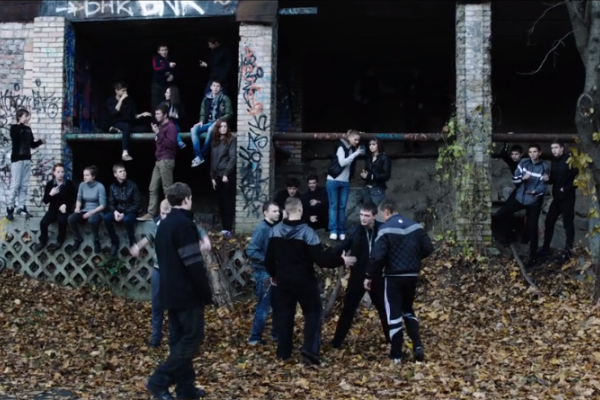Ukrainian director Myroslav Slaboshpytskiy’s new film, The Tribe, takes place at a school for the deaf. It uses only deaf actors, no recorded dialogue, and no subtitles, relying purely on action and emotion to tell its story. It’s a fascinating, electrifyingly original work. It’s also a disturbingly violent film that includes brutal murders, rape, and illegal abortion.
The Tribe is the story of Sergey, a deaf teen who arrives at a new school run by a gang whose activities include prostitution, theft, and bribery. In order to survive, Sergey joins in. At first his transition is seamless, but problems arise when he falls for classmate Anya, one of the gang’s escorts. Their involvement puts Sergey on the outs, and sets off a series of shocking retaliations.
The forms of brutality in The Tribe are hardly new. The film is a spiritual cousin to classic westerns in its plot structure, and to Shakespearean and Jacobean tragedy in terms of escalating violence and the sense that the violence depicted never solves the problem at hand.
Sometimes art is ugly. It carries with it as much capacity for violence and dread as it does transcendent beauty. This is true for film as much as it is with any other medium — it’s why we can have movies like Paris, Texas and Children of Men, and respect them in equal measure.
Difficult subject matter, particularly of the violent or sexual variety as in The Tribe, doesn’t make a film less credible. It’s what the director does with that subject matter that tells us how to react.
And equally important is the approach Slaboshpytskiy takes to what he’s putting on screen. A former crime reporter, the director refuses to stylize his violence in any form, or politely pull away from difficult scenes. The violence in the film is blunt and realistic, a strong commentary on the rampant-but-stylized violence of American cinema.
What is unfortunate about The Tribe is that it’s necessary to defend the tougher parts of the film in order to get to what makes it so great. At its best, The Tribe carries the rare sense that you’re experiencing something truly special, art that is wholly unique. Watching students argue with their teacher in rapid-fire sign language is funny and fascinating. In another scene, the gang swaggers through the school grounds to a spot where their class is gathered, chattering to one another through signed conversations. It conveys the feeling of a noisy, chaotic space without using a single sound.
In terms of cinematic art, The Tribe is a game-changer, showing that an audience doesn’t need a common language — or even spoken language — in order to understand a story. Its violent elements at times threaten to overwhelm its ingenuity, but they’re also necessary in getting to the heart of its characters. This is, after all, a story about passionate teenagers. It’s a story about dark emotions like hatred, pride, and obsession, at an age when those feelings course through our bodies in whitewater rapids of hormones.
The Tribe is a film that opens itself to endless conversations, whether they’re about the nature of its storytelling or the story it chooses to tell.
WATCH the trailer here.
We at Sojourners like talking about films as much as (even more than?) we like watching them. Have you seen The Tribe? Grab some popcorn and share your thoughts with friends, colleagues, or us here in the comments!
1) In an interview, director Myroslav Slaboshpytskiy said, “This is a film about very young people. And very young people are capable of strong, pure feelings: love, hatred, fury, anger, despair.” How do the teenagers in the film express these emotions? Are the director’s interpretation of those emotions are accurate to how you understand teenagers you interact with?
2) How do the girls in the film seem to feel outwardly about their situation? Do you think they really feel this way? Why or why not?
3) Why do you think the adults in the film allow the students to act the way they do? Does their behavior or involvement seem realistic?
4) Do you think the film would have been any more or less affecting if the characters weren’t deaf? Why or why not?
Got something to say about what you're reading? We value your feedback!

